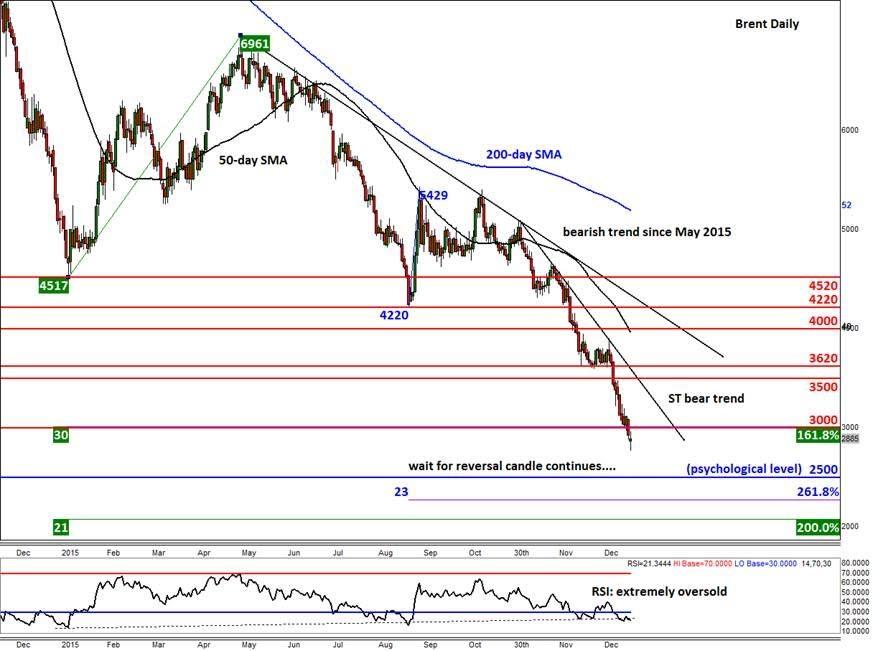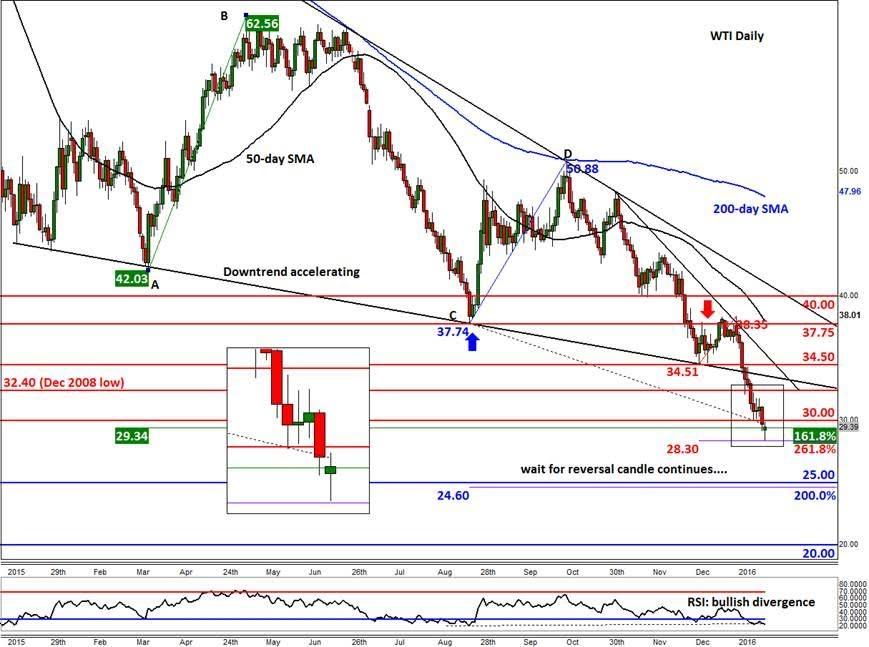![]()
One of the big worries for investors involved in crude has been Iran’s return to the oil market. In July 2015, an agreement was signed between Iran and six world powers to lift its nuclear-related economic sanctions if Tehran completed the steps needed to implement the deal. At the weekend, this deal came into effect after the UN atomic agency confirmed it had verified that Iran has significantly reduced its nuclear infrastructure. As a result, Iran is now able to trade freely and can therefore export more oil. Crude’s immediate response to the news was another 5% drop at the open overnight which saw Brent trade for a time below $28 a barrel, although prices have since made back much of those losses.
Oil’s initial negative reaction to the news regarding Iran was inevitable because it now means there will almost certainly be another increase in the already-excessive global oil supply. Although a 5% drop is significant on a percentage basis, the nominal decline in oil prices wasn’t huge overnight. This is probably because most of the news had already been priced in. The full impact on prices of the fresh oil supplies from Iran may be felt when the market knows for sure how much crude Iran will actually produce and what the response from its competitors will be. I think Iran will easily be able to scale up oil production by up to 500 thousand barrels per day initially. In fact, Iran’s Deputy Oil Minister has reportedly told Shana that the order to increase production [by 500,000 barrels] was issued today." But will the OPEC accommodate for this additional supply by reducing existing output? I have serious doubts about that, especially given the increased tensions between Iran and Saudi Arabia recently. Iran had also claimed previously that it will raise oil production by another 500 thousand to make the total increase a million barrels per day about 6 months after the sanctions are lifted. To do this, Iran may have to sell its oil cheaper in order to attract fresh customers, and this may start a price war within the OPEC.
So, whichever way you look at it, the OPEC supply will remain high this year and if oil prices were to stage a significant recovery it will mostly likely happen because of a sharp decrease in non-OPEC supply, or a sudden increase in demand. Up until now, shale oil producers in the US and elsewhere have remained surprisingly resilient to the significantly lower crude prices. However, Baker Hughes’ rigs data does point to reduced drilling activity in the US after consistent falls in the oil rig counts. But a meaningful reduction in supply may be months away. At the moment, US oil inventories are at record high levels and still rising as official data from the US Department of Energy showed last week. So in the short-term, the glut is here to stay, even in the US. But in the medium term, the oil surplus is likely to shift eastwards and the process has already began, which may also explain why WTI is now trading at a premium over Brent.
On the other side of the equation, demand has undoubtedly risen due to the significantly lower oil prices. Basic economic theory would suggest that there has been a downward movement along the demand curve, but perhaps not an outward shift of the curve itself. For that to happen, we will need to see a jump in global incomes, most notably from the big oil consumer nations such as China and the US. The latest macro data however suggests these economies, especially China, are struggling to sustain their growth rates. So, the rate of increase in demand growth is probably not rising as fast as it otherwise would have – if it had, the glut may have been reduced meaningfully already. For short-term speculators, Tuesday’s GDP data from China should therefore be watched closely as it will give an indication about demand from the world’s second largest oil consumer.
So, there are still lots of uncertainty about both supply and demand forces and for that reason the near term outlook for oil remains murky. Traders may get a better ‘feel’ for the direction of oil prices by analysing the charts instead. On this front, both crude contracts have 'filled' their overnight gaps, so it will be interesting to see where prices are headed now with most of the bad news already in the price. But with both Brent and WTI prices below the $30 handle, the bias remains bearish for now and the next potential stop could well be at the next psychological handles of $25 or even $20 a barrel. However, if oil manages to rally and close back above $30, then this would suggest that a near-term bottom may have been formed. Even so, there will still be plenty of resistance levels (such as those shown on the charts) the bulls will need to tackle before a reversal can be confirmed.
Trading leveraged products such as FX, CFDs and Spread Bets carry a high level of risk which means you could lose your capital and is therefore not suitable for all investors. All of this website’s contents and information provided by Fawad Razaqzada elsewhere, such as on telegram and other social channels, including news, opinions, market analyses, trade ideas, trade signals or other information are solely provided as general market commentary and do not constitute a recommendation or investment advice. Please ensure you fully understand the risks involved by reading our disclaimer, terms and policies.
Recommended Content
Editors’ Picks
EUR/USD edges lower toward 1.0700 post-US PCE

EUR/USD stays under modest bearish pressure but manages to hold above 1.0700 in the American session on Friday. The US Dollar (USD) gathers strength against its rivals after the stronger-than-forecast PCE inflation data, not allowing the pair to gain traction.
GBP/USD retreats to 1.2500 on renewed USD strength

GBP/USD lost its traction and turned negative on the day near 1.2500. Following the stronger-than-expected PCE inflation readings from the US, the USD stays resilient and makes it difficult for the pair to gather recovery momentum.
Gold struggles to hold above $2,350 following US inflation

Gold turned south and declined toward $2,340, erasing a large portion of its daily gains, as the USD benefited from PCE inflation data. The benchmark 10-year US yield, however, stays in negative territory and helps XAU/USD limit its losses.
Bitcoin Weekly Forecast: BTC’s next breakout could propel it to $80,000 Premium

Bitcoin’s recent price consolidation could be nearing its end as technical indicators and on-chain metrics suggest a potential upward breakout. However, this move would not be straightforward and could punish impatient investors.
Week ahead – Hawkish risk as Fed and NFP on tap, Eurozone data eyed too

Fed meets on Wednesday as US inflation stays elevated. Will Friday’s jobs report bring relief or more angst for the markets? Eurozone flash GDP and CPI numbers in focus for the Euro.

